University Law Assignment: LAW 504 Case Study on Contract and Tort Law
VerifiedAdded on 2021/04/17
|6
|1261
|144
Case Study
AI Summary
This case study, prepared for LAW 504, examines several legal issues related to contract and tort law. The analysis begins by defining negligence and its application in a scenario where Emma provides incorrect information to Richard, leading to financial loss. The study then explores a lease agreement between Richard and George, focusing on the enforceability of a 10% annual rent increase. Furthermore, the case delves into a contract between Richard and Tom for the sale of a car, addressing the breach of contract when Tom refuses to purchase. Finally, it examines a situation where Richard breaches a contract with Martin regarding the use of his car. The analysis applies relevant legal principles, including the Contract Act and the concept of negligence, to determine the liabilities of each party involved, supported by references to legal precedents and scholarly articles.
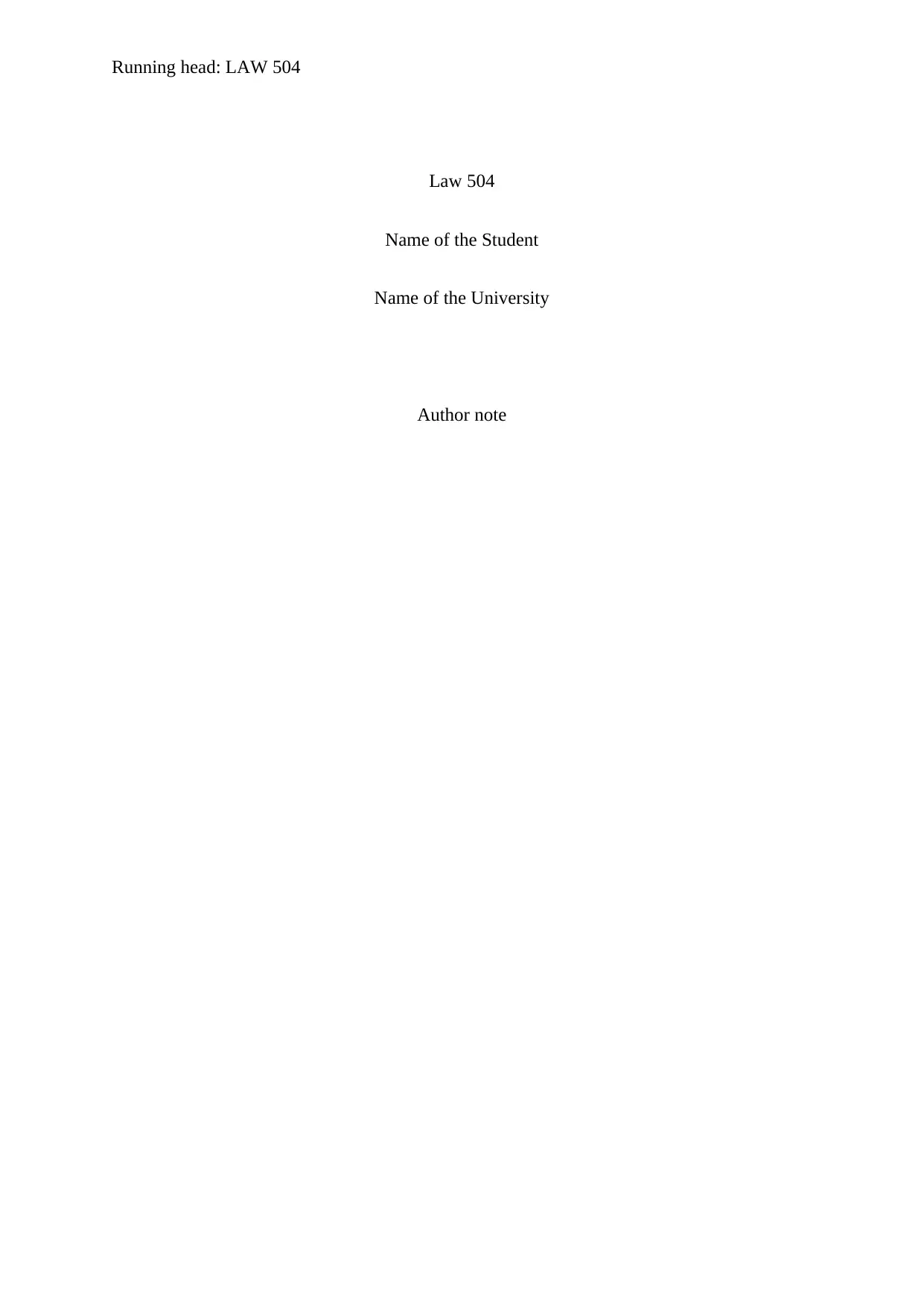
Running head: LAW 504
Law 504
Name of the Student
Name of the University
Author note
Law 504
Name of the Student
Name of the University
Author note
Paraphrase This Document
Need a fresh take? Get an instant paraphrase of this document with our AI Paraphraser
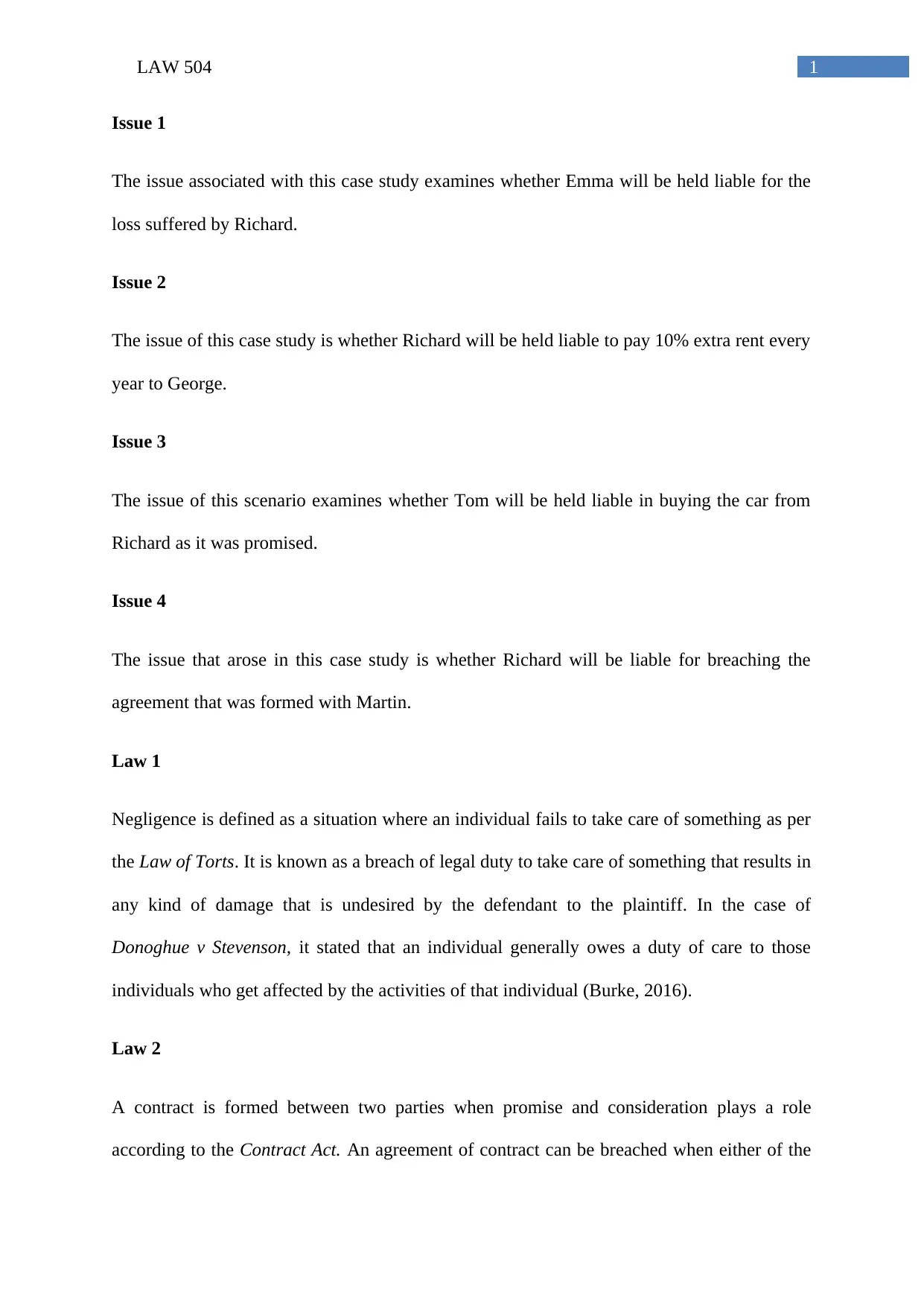
1LAW 504
Issue 1
The issue associated with this case study examines whether Emma will be held liable for the
loss suffered by Richard.
Issue 2
The issue of this case study is whether Richard will be held liable to pay 10% extra rent every
year to George.
Issue 3
The issue of this scenario examines whether Tom will be held liable in buying the car from
Richard as it was promised.
Issue 4
The issue that arose in this case study is whether Richard will be liable for breaching the
agreement that was formed with Martin.
Law 1
Negligence is defined as a situation where an individual fails to take care of something as per
the Law of Torts. It is known as a breach of legal duty to take care of something that results in
any kind of damage that is undesired by the defendant to the plaintiff. In the case of
Donoghue v Stevenson, it stated that an individual generally owes a duty of care to those
individuals who get affected by the activities of that individual (Burke, 2016).
Law 2
A contract is formed between two parties when promise and consideration plays a role
according to the Contract Act. An agreement of contract can be breached when either of the
Issue 1
The issue associated with this case study examines whether Emma will be held liable for the
loss suffered by Richard.
Issue 2
The issue of this case study is whether Richard will be held liable to pay 10% extra rent every
year to George.
Issue 3
The issue of this scenario examines whether Tom will be held liable in buying the car from
Richard as it was promised.
Issue 4
The issue that arose in this case study is whether Richard will be liable for breaching the
agreement that was formed with Martin.
Law 1
Negligence is defined as a situation where an individual fails to take care of something as per
the Law of Torts. It is known as a breach of legal duty to take care of something that results in
any kind of damage that is undesired by the defendant to the plaintiff. In the case of
Donoghue v Stevenson, it stated that an individual generally owes a duty of care to those
individuals who get affected by the activities of that individual (Burke, 2016).
Law 2
A contract is formed between two parties when promise and consideration plays a role
according to the Contract Act. An agreement of contract can be breached when either of the
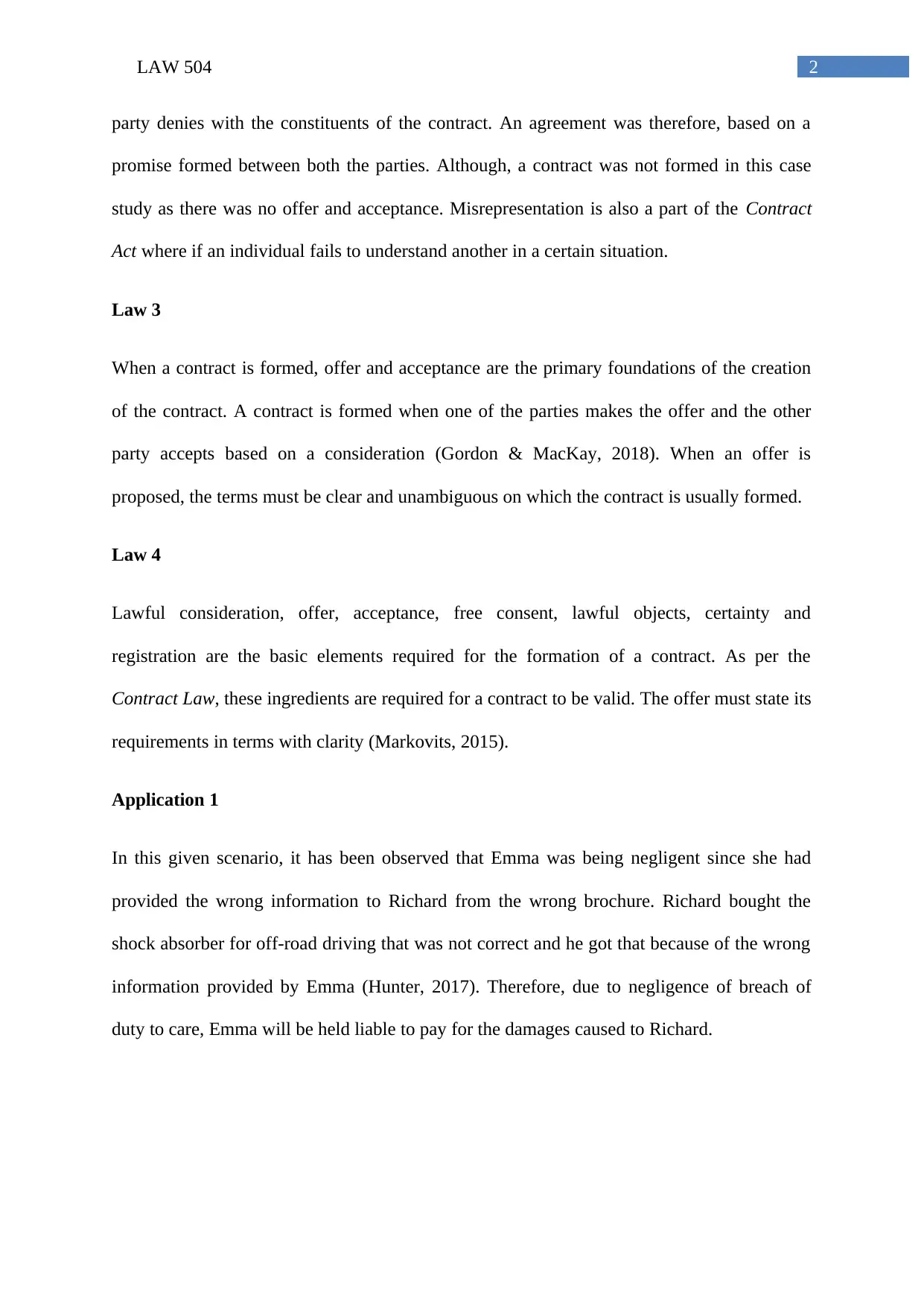
2LAW 504
party denies with the constituents of the contract. An agreement was therefore, based on a
promise formed between both the parties. Although, a contract was not formed in this case
study as there was no offer and acceptance. Misrepresentation is also a part of the Contract
Act where if an individual fails to understand another in a certain situation.
Law 3
When a contract is formed, offer and acceptance are the primary foundations of the creation
of the contract. A contract is formed when one of the parties makes the offer and the other
party accepts based on a consideration (Gordon & MacKay, 2018). When an offer is
proposed, the terms must be clear and unambiguous on which the contract is usually formed.
Law 4
Lawful consideration, offer, acceptance, free consent, lawful objects, certainty and
registration are the basic elements required for the formation of a contract. As per the
Contract Law, these ingredients are required for a contract to be valid. The offer must state its
requirements in terms with clarity (Markovits, 2015).
Application 1
In this given scenario, it has been observed that Emma was being negligent since she had
provided the wrong information to Richard from the wrong brochure. Richard bought the
shock absorber for off-road driving that was not correct and he got that because of the wrong
information provided by Emma (Hunter, 2017). Therefore, due to negligence of breach of
duty to care, Emma will be held liable to pay for the damages caused to Richard.
party denies with the constituents of the contract. An agreement was therefore, based on a
promise formed between both the parties. Although, a contract was not formed in this case
study as there was no offer and acceptance. Misrepresentation is also a part of the Contract
Act where if an individual fails to understand another in a certain situation.
Law 3
When a contract is formed, offer and acceptance are the primary foundations of the creation
of the contract. A contract is formed when one of the parties makes the offer and the other
party accepts based on a consideration (Gordon & MacKay, 2018). When an offer is
proposed, the terms must be clear and unambiguous on which the contract is usually formed.
Law 4
Lawful consideration, offer, acceptance, free consent, lawful objects, certainty and
registration are the basic elements required for the formation of a contract. As per the
Contract Law, these ingredients are required for a contract to be valid. The offer must state its
requirements in terms with clarity (Markovits, 2015).
Application 1
In this given scenario, it has been observed that Emma was being negligent since she had
provided the wrong information to Richard from the wrong brochure. Richard bought the
shock absorber for off-road driving that was not correct and he got that because of the wrong
information provided by Emma (Hunter, 2017). Therefore, due to negligence of breach of
duty to care, Emma will be held liable to pay for the damages caused to Richard.
⊘ This is a preview!⊘
Do you want full access?
Subscribe today to unlock all pages.

Trusted by 1+ million students worldwide
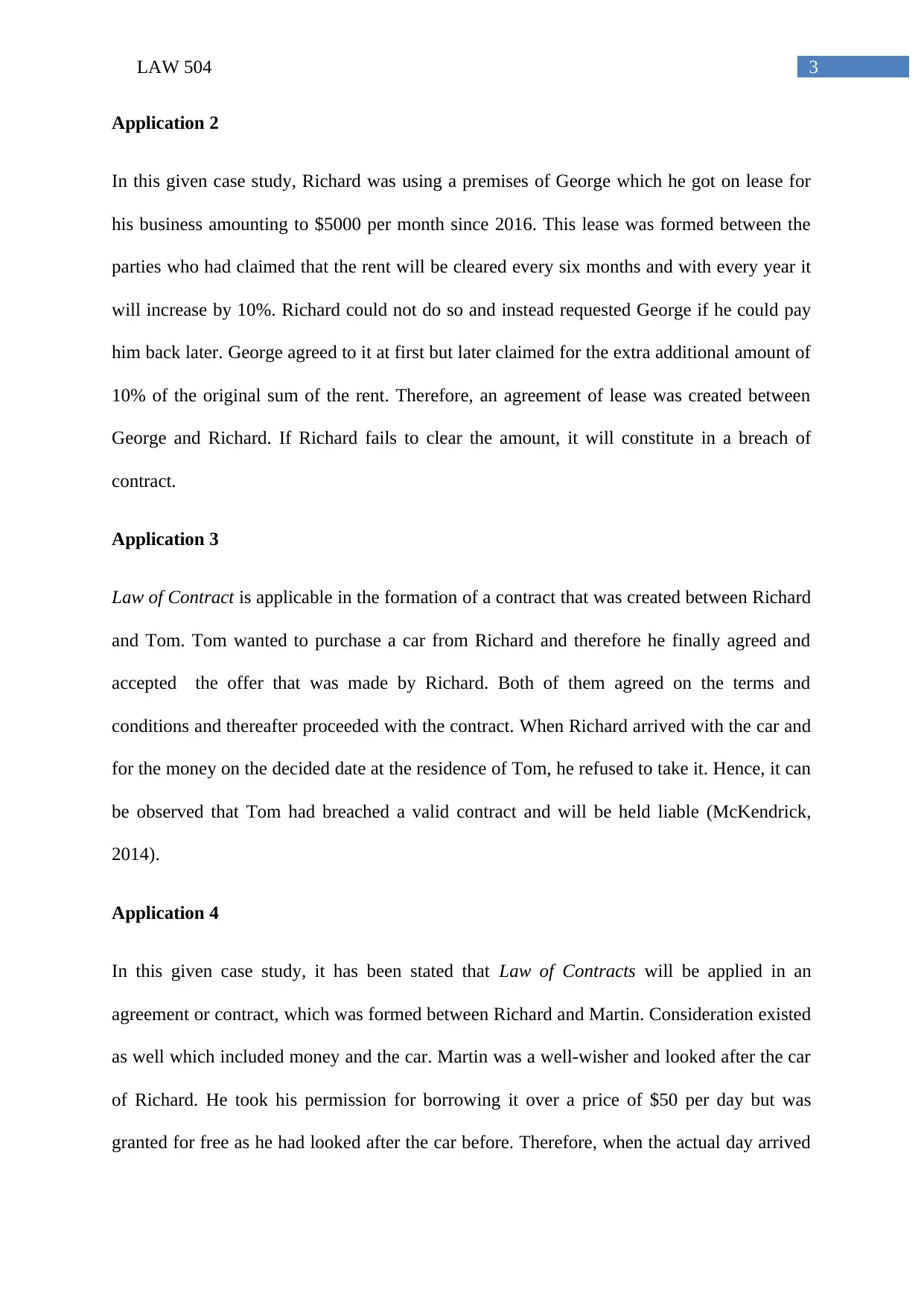
3LAW 504
Application 2
In this given case study, Richard was using a premises of George which he got on lease for
his business amounting to $5000 per month since 2016. This lease was formed between the
parties who had claimed that the rent will be cleared every six months and with every year it
will increase by 10%. Richard could not do so and instead requested George if he could pay
him back later. George agreed to it at first but later claimed for the extra additional amount of
10% of the original sum of the rent. Therefore, an agreement of lease was created between
George and Richard. If Richard fails to clear the amount, it will constitute in a breach of
contract.
Application 3
Law of Contract is applicable in the formation of a contract that was created between Richard
and Tom. Tom wanted to purchase a car from Richard and therefore he finally agreed and
accepted the offer that was made by Richard. Both of them agreed on the terms and
conditions and thereafter proceeded with the contract. When Richard arrived with the car and
for the money on the decided date at the residence of Tom, he refused to take it. Hence, it can
be observed that Tom had breached a valid contract and will be held liable (McKendrick,
2014).
Application 4
In this given case study, it has been stated that Law of Contracts will be applied in an
agreement or contract, which was formed between Richard and Martin. Consideration existed
as well which included money and the car. Martin was a well-wisher and looked after the car
of Richard. He took his permission for borrowing it over a price of $50 per day but was
granted for free as he had looked after the car before. Therefore, when the actual day arrived
Application 2
In this given case study, Richard was using a premises of George which he got on lease for
his business amounting to $5000 per month since 2016. This lease was formed between the
parties who had claimed that the rent will be cleared every six months and with every year it
will increase by 10%. Richard could not do so and instead requested George if he could pay
him back later. George agreed to it at first but later claimed for the extra additional amount of
10% of the original sum of the rent. Therefore, an agreement of lease was created between
George and Richard. If Richard fails to clear the amount, it will constitute in a breach of
contract.
Application 3
Law of Contract is applicable in the formation of a contract that was created between Richard
and Tom. Tom wanted to purchase a car from Richard and therefore he finally agreed and
accepted the offer that was made by Richard. Both of them agreed on the terms and
conditions and thereafter proceeded with the contract. When Richard arrived with the car and
for the money on the decided date at the residence of Tom, he refused to take it. Hence, it can
be observed that Tom had breached a valid contract and will be held liable (McKendrick,
2014).
Application 4
In this given case study, it has been stated that Law of Contracts will be applied in an
agreement or contract, which was formed between Richard and Martin. Consideration existed
as well which included money and the car. Martin was a well-wisher and looked after the car
of Richard. He took his permission for borrowing it over a price of $50 per day but was
granted for free as he had looked after the car before. Therefore, when the actual day arrived
Paraphrase This Document
Need a fresh take? Get an instant paraphrase of this document with our AI Paraphraser
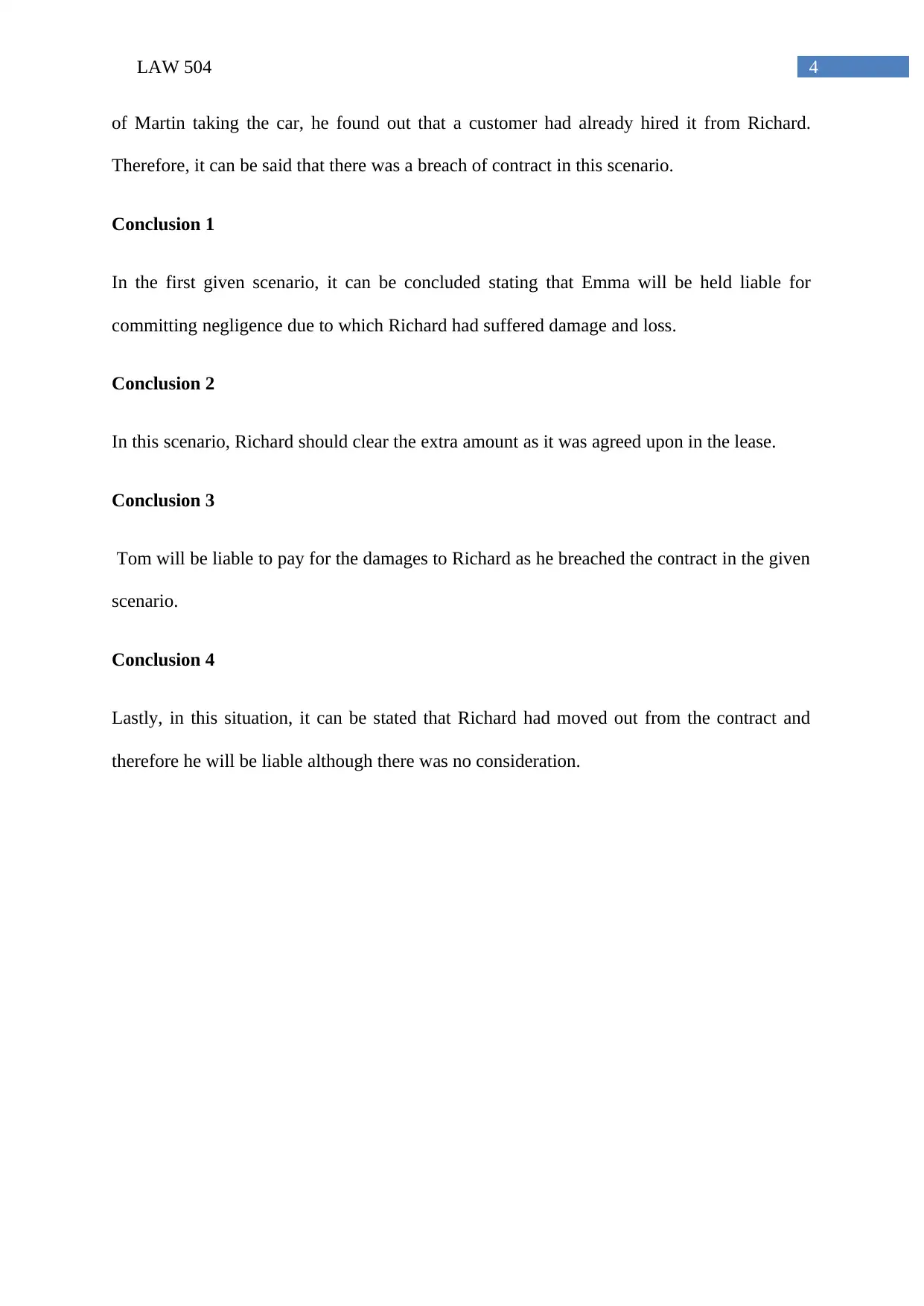
4LAW 504
of Martin taking the car, he found out that a customer had already hired it from Richard.
Therefore, it can be said that there was a breach of contract in this scenario.
Conclusion 1
In the first given scenario, it can be concluded stating that Emma will be held liable for
committing negligence due to which Richard had suffered damage and loss.
Conclusion 2
In this scenario, Richard should clear the extra amount as it was agreed upon in the lease.
Conclusion 3
Tom will be liable to pay for the damages to Richard as he breached the contract in the given
scenario.
Conclusion 4
Lastly, in this situation, it can be stated that Richard had moved out from the contract and
therefore he will be liable although there was no consideration.
of Martin taking the car, he found out that a customer had already hired it from Richard.
Therefore, it can be said that there was a breach of contract in this scenario.
Conclusion 1
In the first given scenario, it can be concluded stating that Emma will be held liable for
committing negligence due to which Richard had suffered damage and loss.
Conclusion 2
In this scenario, Richard should clear the extra amount as it was agreed upon in the lease.
Conclusion 3
Tom will be liable to pay for the damages to Richard as he breached the contract in the given
scenario.
Conclusion 4
Lastly, in this situation, it can be stated that Richard had moved out from the contract and
therefore he will be liable although there was no consideration.
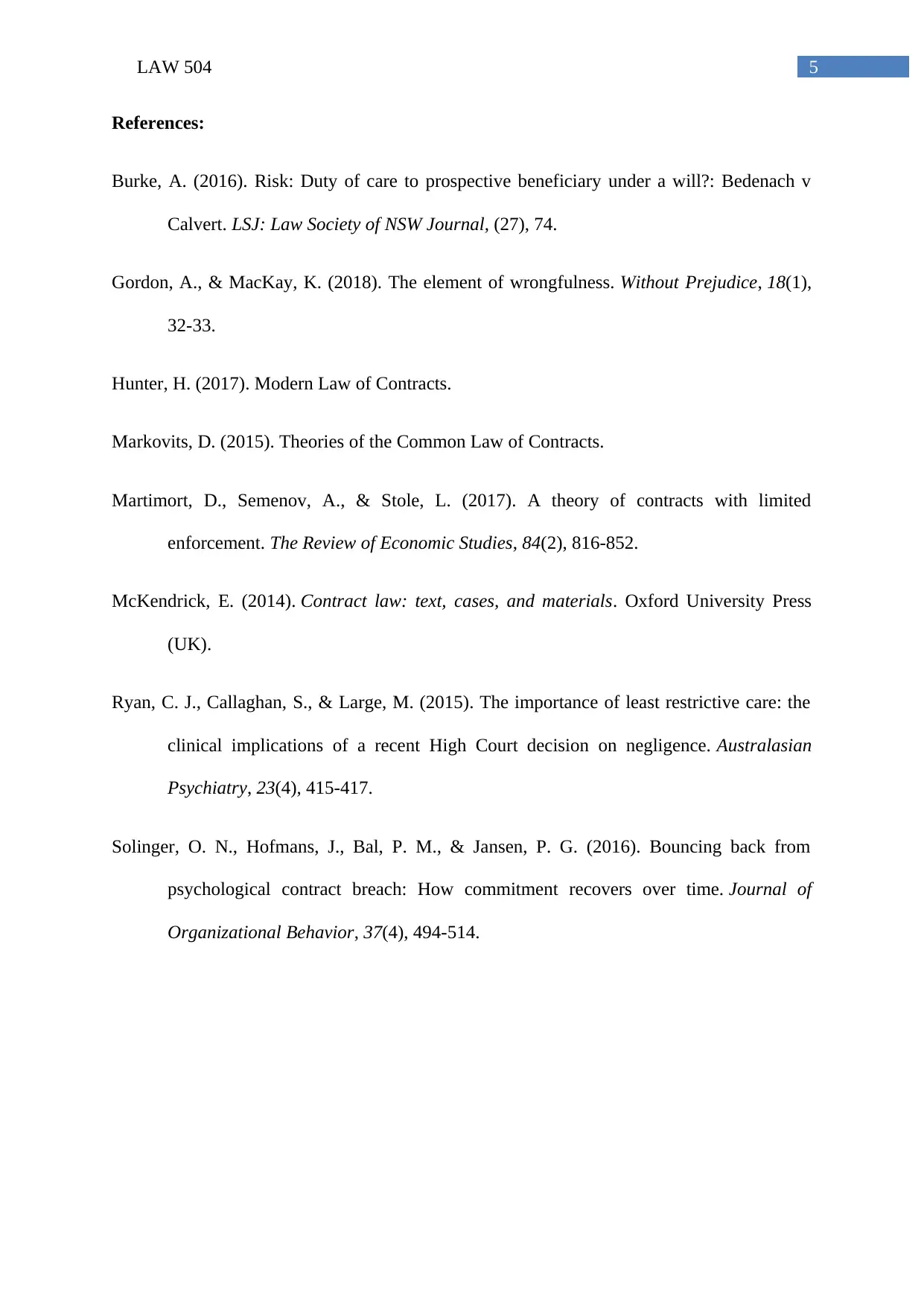
5LAW 504
References:
Burke, A. (2016). Risk: Duty of care to prospective beneficiary under a will?: Bedenach v
Calvert. LSJ: Law Society of NSW Journal, (27), 74.
Gordon, A., & MacKay, K. (2018). The element of wrongfulness. Without Prejudice, 18(1),
32-33.
Hunter, H. (2017). Modern Law of Contracts.
Markovits, D. (2015). Theories of the Common Law of Contracts.
Martimort, D., Semenov, A., & Stole, L. (2017). A theory of contracts with limited
enforcement. The Review of Economic Studies, 84(2), 816-852.
McKendrick, E. (2014). Contract law: text, cases, and materials. Oxford University Press
(UK).
Ryan, C. J., Callaghan, S., & Large, M. (2015). The importance of least restrictive care: the
clinical implications of a recent High Court decision on negligence. Australasian
Psychiatry, 23(4), 415-417.
Solinger, O. N., Hofmans, J., Bal, P. M., & Jansen, P. G. (2016). Bouncing back from
psychological contract breach: How commitment recovers over time. Journal of
Organizational Behavior, 37(4), 494-514.
References:
Burke, A. (2016). Risk: Duty of care to prospective beneficiary under a will?: Bedenach v
Calvert. LSJ: Law Society of NSW Journal, (27), 74.
Gordon, A., & MacKay, K. (2018). The element of wrongfulness. Without Prejudice, 18(1),
32-33.
Hunter, H. (2017). Modern Law of Contracts.
Markovits, D. (2015). Theories of the Common Law of Contracts.
Martimort, D., Semenov, A., & Stole, L. (2017). A theory of contracts with limited
enforcement. The Review of Economic Studies, 84(2), 816-852.
McKendrick, E. (2014). Contract law: text, cases, and materials. Oxford University Press
(UK).
Ryan, C. J., Callaghan, S., & Large, M. (2015). The importance of least restrictive care: the
clinical implications of a recent High Court decision on negligence. Australasian
Psychiatry, 23(4), 415-417.
Solinger, O. N., Hofmans, J., Bal, P. M., & Jansen, P. G. (2016). Bouncing back from
psychological contract breach: How commitment recovers over time. Journal of
Organizational Behavior, 37(4), 494-514.
⊘ This is a preview!⊘
Do you want full access?
Subscribe today to unlock all pages.

Trusted by 1+ million students worldwide
1 out of 6
Related Documents
Your All-in-One AI-Powered Toolkit for Academic Success.
+13062052269
info@desklib.com
Available 24*7 on WhatsApp / Email
![[object Object]](/_next/static/media/star-bottom.7253800d.svg)
Unlock your academic potential
Copyright © 2020–2025 A2Z Services. All Rights Reserved. Developed and managed by ZUCOL.





